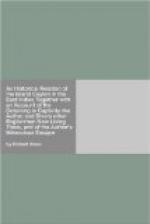These Moors Pilgrims have many pieces of Land given them by well disposed persons out of charity, where they build houses and live. And this land becomes theirs from generation to generation for ever.
[They respect Christians, and why.] They lay Flowers, out of religion, before their Images every morning and evening, for which Images they build little Chappels in their yards as we said before. They carry beads in their hands on strings, and say so many prayers as they go. Which custom in all probability they borrowed of the Portugueze. They love a man that makes conscience of his ways. Which makes them respect Christians more than any others, because they think they are just and will not lye. And thus we have finished our discourse of their Religion.
CHAP. VI.
Concerning their Houses, Diet, Housewifry, Salutation, Apparel.
Having already treated of their Religion, we now come to their secular concerns. And first we will lead you into their houses, and shew you how they live.
[Their houses.] Their Houses are small, low, thatched Cottages, built with sticks, daubed with clay, the walls made very smooth. For they are not permitted to build their houses above one story high, neither may they cover with tiles, nor whiten their walls with lime, but there is a Clay which is as white, and that they use sometimes. They employ no Carpenters, or house-builders, unless some few noble-men, but each one buildeth his own dwelling. In building whereof there is not so much as a nail used; but instead of them every thing which might be nailed, is tyed with rattans and other strings, which grow in the woods in abundance; whence the builder hath his Timber for cutting. The Country being warm, many of them will not take pains to clay their walls, but make them of boughs and leaves of Trees. The poorest sort have not above one room in their houses, few above two, unless they be great men. Neither doth the King allow them to build better.
[No chimneys.] They are not nice nor curious in their houses. They have no Chimneys in them, but make their fires in one corner, so that the roof is all blacked with the smoak.
[The houses of the better sort.] The great people have handsom and commodious houses. They have commonly two buildings one opposit to the other, joined together on each side with a wall, which makes a square Court-yard in the middle. Round about against the walls of their houses are banks of clay to sit on; which they often daub over with soft Cow-dung, to keep them smooth and clean. Their Slaves and Servants dwell round about without in other houses with their wives and children.




